Analysis and Comparison of Ultra-wide Input Range Railway Power Supply Solutions
CONTENT:
3. Traditional Solution: Connecting Electrolytic Capacitors in Parallel at the Input End
5. Mainstream Solution②: Single-stage topology + Passive BUCK
6. New Technology Upgrade: Active hold-up time protection circuit
1. Foreword
The global mainstream railway systems are powered by multi-voltage, which makes the power module unable to be normalized to realize the hold-up time protection, increasing the design difficulty and management cost of the customer application system. For this problem, MORNSUN invented an active hold-up time protection circuit to be compatible with the ultra-wide voltage input range and capacitance normalization. This article compares and summarizes the ultra-wide input range railway power supply solutions by analyzing the pros and cons of several common railway power supply solutions on the market.
2. Difficulties in circuit design
In the global mainstream railway control systems, the power supply voltage requires for internal control systems in most countries, such as Germany, America, France, and India includes 24V, 28V, 36V, 48V, 72V, 96V and 110V. As a result, one power supply can not be normalized to multiple systems, which increases the difficulty and management cost of customer system design.
According to the EN50155 standard, the DC power supply module must stably power the back-end equipment within the fluctuation range of the input voltage. Even if there is a maximum voltage fluctuation, the power supply module should output normally and protect the stability of the back-end equipment. The N50155 standard requires that the power supply equipment work stably in the voltage fluctuation range of 0.7 times to 1.25 times, that is 16.8V~137.5V, and if the fluctuation range to 0.6 times and 1.4 times, then the working time are only required to be 100ms and 1s respectively. To meet the power supply requirements and certification requirements of the global railway system, the input range of the ultra-wide input range power module is best designed to be 14V~160V.
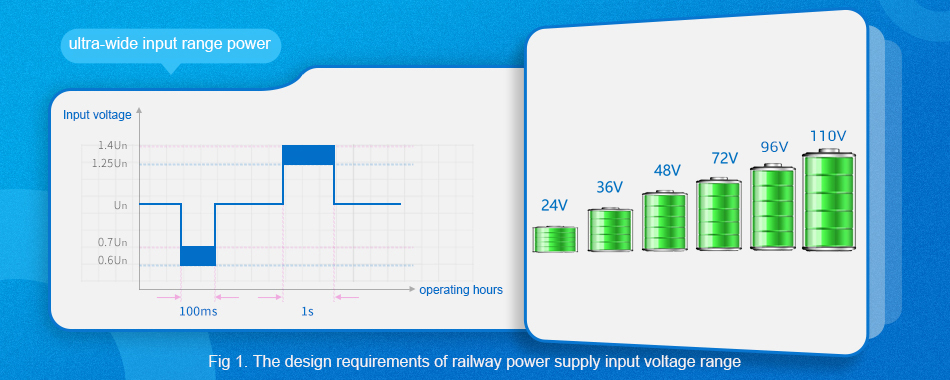
At the same time, the railway system has high-reliability requirements that the backend equipment can store the hold-up time state data and switch to the backup power supply in an orderly manner after the power supply is cut off. Therefore, it is required to have an energy storage capacitor at the front end of the power module to keep the Hold-up time protection time for 10ms.
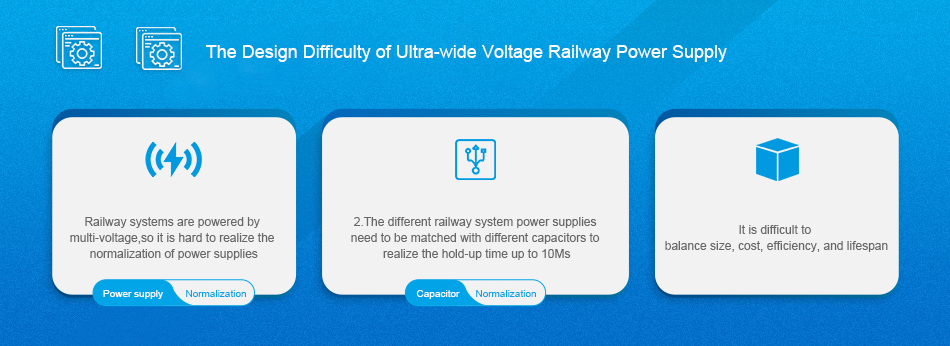
3. Traditional Solution: Connecting Electrolytic Capacitors in Parallel at the Input End
In the traditional solution, the hold-up time protection is generally realized by connecting an electrolytic capacitor in parallel at the input end.
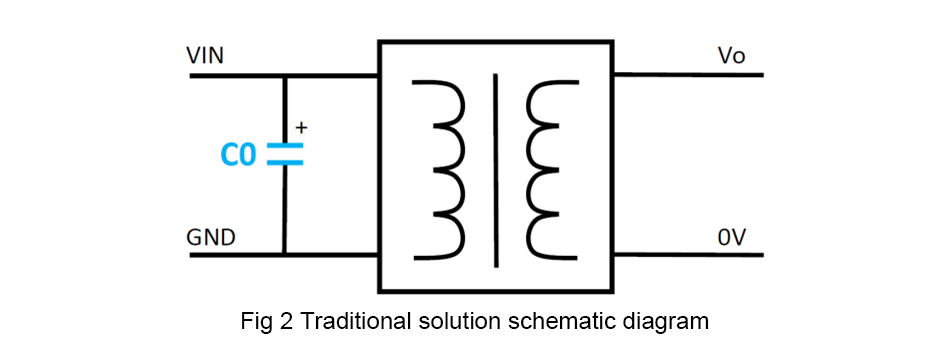
According to the capacitor energy storage formula: W=1/2*C*U2 and the discharge time formula: t=RC*Ln*U/Ut, it shows that the higher the input voltage value (U) is, the more energy (W) is stored, and the longer the hold-up time protection time (t) is when the capacitance value (C) is the same. Conversely, the lower the input voltage value (U) is, the smaller the stored energy (W) under the same conditions and the shorter the hold-up time protection time. This phenomenon is exacerbated by the squared difference relationship between the voltage changes.
Since the power supply's input voltage range is very wide, if the external energy storage capacitor is selected according to the maximum input voltage, the capacitance value of the capacitor will be huge to be compatible with the application of the low-voltage system. In the below, in a maximum input voltage is up to 160V system with 100W, the capacitance of the energy storage capacitor would be around 190uF to realize a hold-up time protection time of 10ms, but if it is compatible with a 24V system, the capacitance would be up to 8000uF, the size of the external energy storage capacitor will be more huge (about 3.8 times that of a quarter-brick power module).
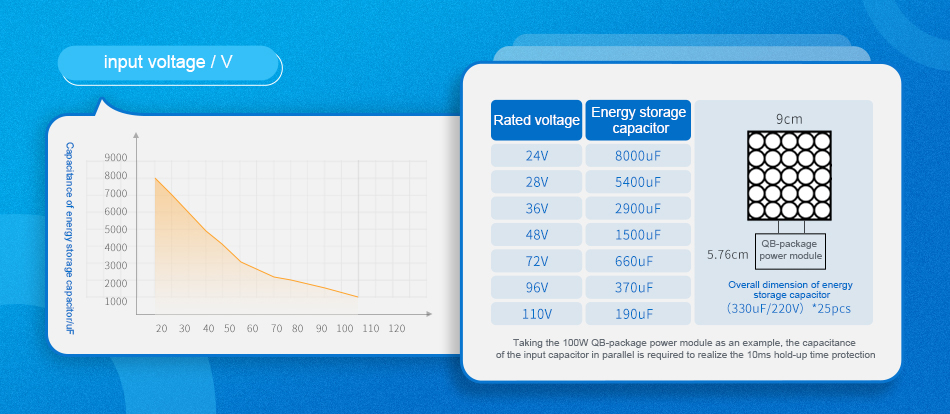
The common solution in the railway industry is to recommend external energy storage capacitors with different withstand voltages according to different application systems of customers to address the above problem. However, it will lead to the inability to normalize the customer's system, which loses the original design intention of the ultra-wide input range power supply module and increases customer system design difficulty, material management costs, and certification costs.
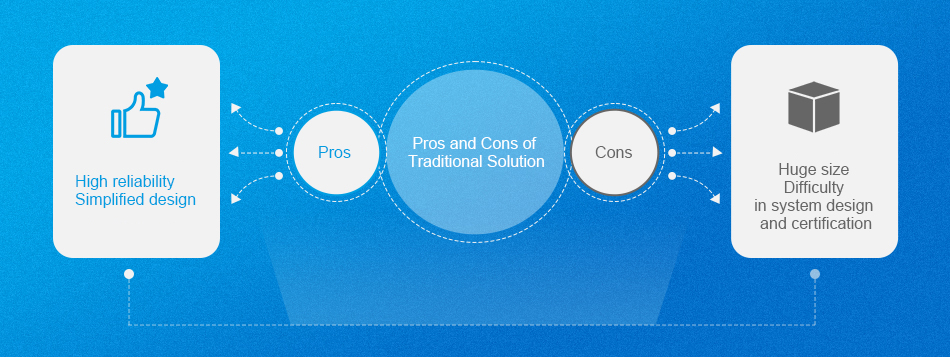
4. Mainstream Solution ①: Two-stage Topology
Traditional solutions are gradually being abandoned, nowadays, the mainstream solution on the market is a two-stage topology. The front-stage topology adopts a Boost boosted circuit, and the rear-stage is a common topology such as a flyback, half-bridge, or full-bridge circuit. An external energy storage capacitor is placed between the two-stage topologies, that is, the output end of the boost circuit.
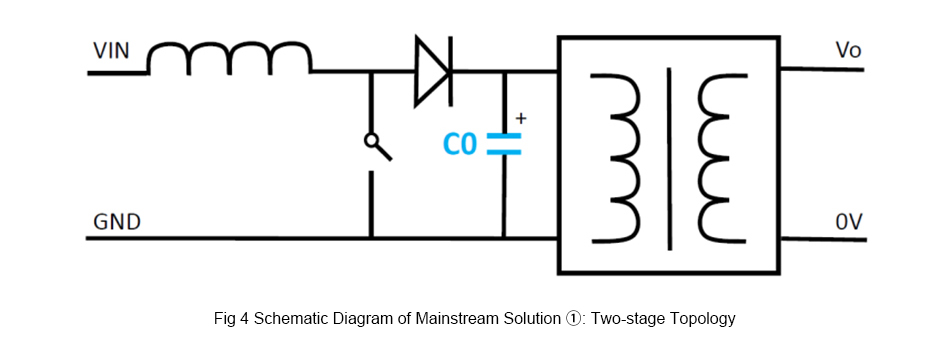
When the low input voltage is input, it will be raised by the boost circuit to the set high voltage value to charge the external energy storage capacitor; when the high input voltage is entered, it will pass through the boost circuit and directly charge the external energy storage capacitor. So in this solution, electrolytic energy storage capacitors with large withstand voltage and small capacitance can be chosen, which can continuously provide power to the subsequent stage to realize the required hold-up time protection time when the input voltage is cut off.
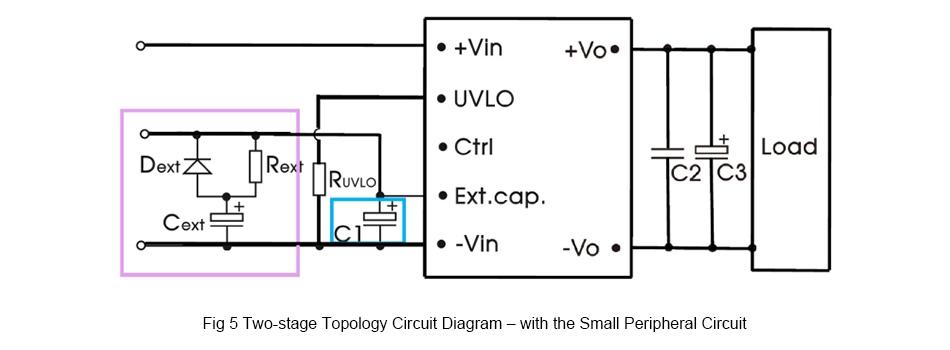
The efficiency would be too low to apply to high-power density products due to the two-stage series connection used in the circuit. As the capacitive load of the boost circuit, the external energy storage capacitor cannot be directly added to the output end. It must add a small peripheral circuit and a large capacitor to prevent poor startup.
There are two flaws to this solution:
① Compared with the single-stage charging scheme, the complexity of circuit topology with a two-stage series connection is greatly increased, which greatly increases the cost, while reducing the reliability of the customer's system to a certain extent.
② Compared with the single-stage charging solution, the overall efficiency of the two-stage series charging solution will be reduced, which will bring about a temperature rise increasing the high-power power supply and the system, and reducing the life of the power supply and the system.
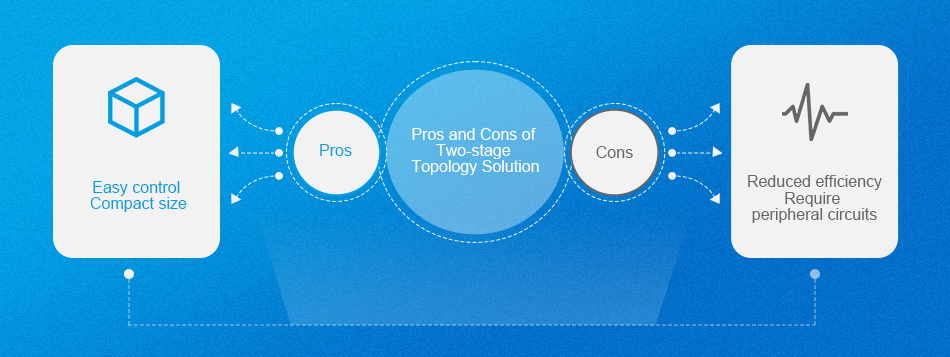
5. Mainstream Solution②: Single-stage topology + Passive BUCK
In recent years, the solution with single-stage topology + passive BUCK has appeared, which improves efficiency and reliability compared with two-stage topology.
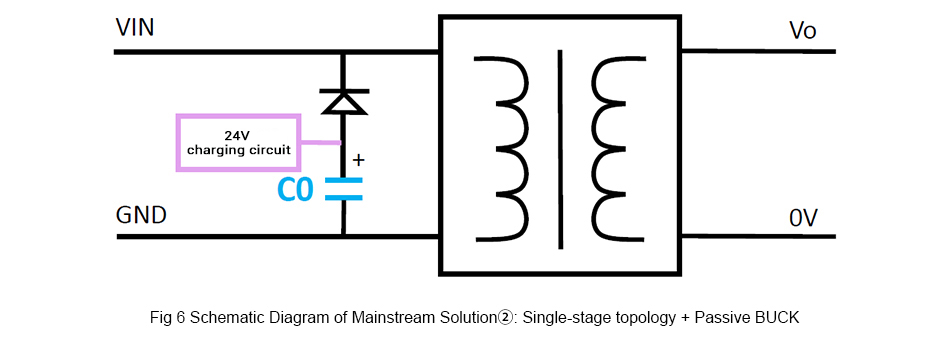
Taking the mainstream BUCK charging solutions on the market as an example, when the input voltage(>24V) is input and the circuit is turned on normally, the buck circuit will clamp the input voltage at the set low voltage value of 22V and the charging circuit will charge the external capacitor concurrently. While the input voltage is reduced below 22V, the external capacitor will be switched in through the diode to provide the stored power to the back end, thereby maintaining a hold-up time protection time of 10ms. So when the input voltage is higher than 22V, the hold-up time protection function is normally executed. At this time, the system only needs an 8000uF electrolytic capacitor with a withstand voltage of 35V.
However, when the input voltage is less than 22V, the voltage of the external capacitor is the same as the input voltage, and its energy storage would be not enough to maintain the hold-up time protection function for 10ms. When the customer system needs the under-voltage protection function, such as a 48V system, the under-voltage protection is set at 27V, and the charging voltage of the energy storage capacitor is 22V. When the input is powered off, the energy storage capacitor needs to be below 22V before the input starts to discharge, but the 22V would not be enough to turn on the under-voltage point of the power supply, then the system is turned off, which means the invalid of the hold-up time protection function.

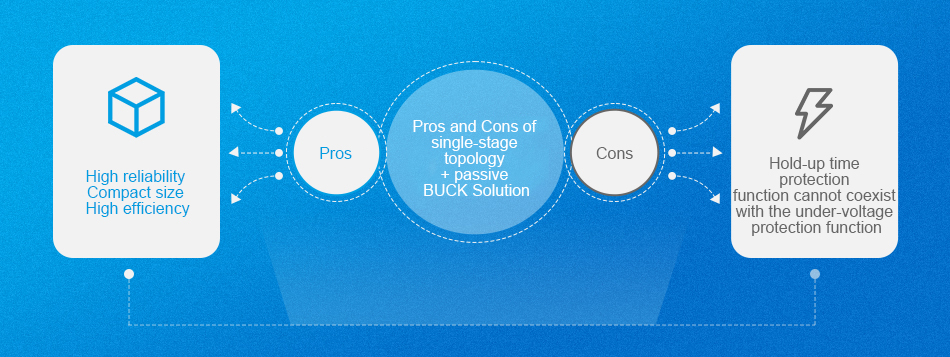
6. New Technology Upgrade: Active hold-up time protection circuit
Mornsun invented an active hold-up time protection circuit, which makes a power module not only with an ultra-wide voltage but also achieves a normalized power supply that features a compact size, fixed simple peripheral circuit for various railway systems.
This circuit is built in an energy pre-storage module and an input hold-up time automatic switching module. The energy pre-storage module can minimize the capacitor volume and maximize the energy storage through precise design and calculation. The hold-up time automatic switching module can detect the state of the input voltage in real time. Once the input voltage is cut off, the external capacitor will supply the input end of the main power actively, to make the product continue to work for 10ms, for the back-end equipment storing the hold-up time state data and switching to the backup power supply to realize automatic and smooth switching.

At the same time, the active hold-up time protection circuit has programmable under-voltage protection. When customers adjust the under-voltage point to apply to different power supply systems, this solution can ensure hold-up time protection of 10ms in the full input voltage range.
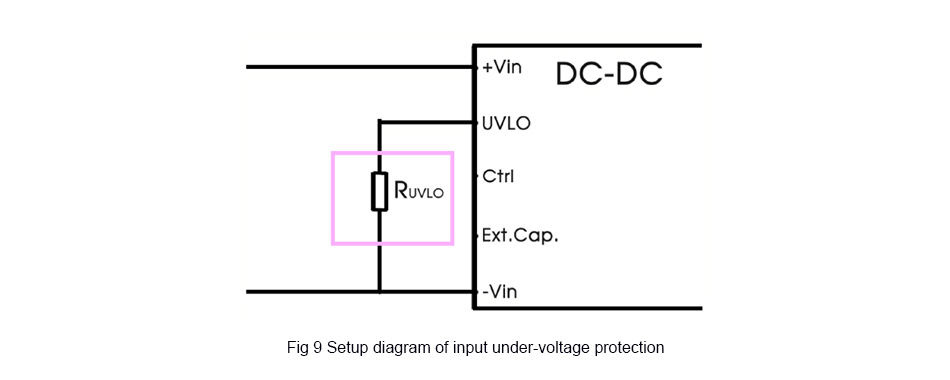
This technology has been successfully applied to Mornsun's railway power supply, the UWTH1DxxQB-100WR3 series. This series features an ultra-wide input voltage range of 14-160VDC, which meets the input voltage requirements of global mainstream railway systems; Realizing a hold-up time protection function for 10ms with a simple and fixed peripheral circuit and a 470uF only electrolytic capacitor; The input under-voltage protection can be adjusted by changing the external resistance; Operating altitude up to 5000m, high isolation voltage up to 4000VAC.
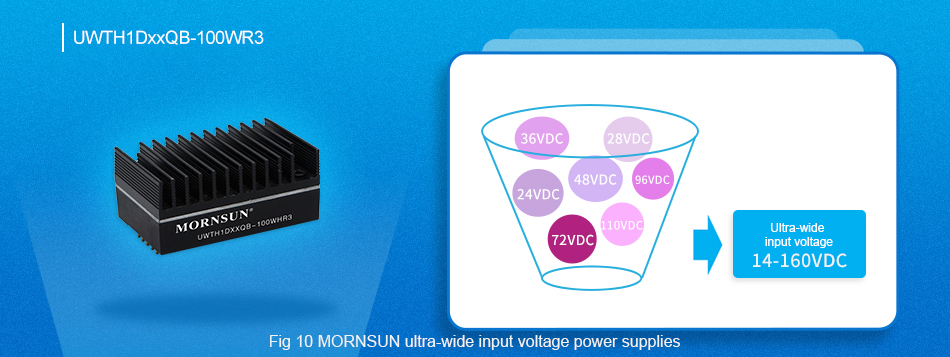
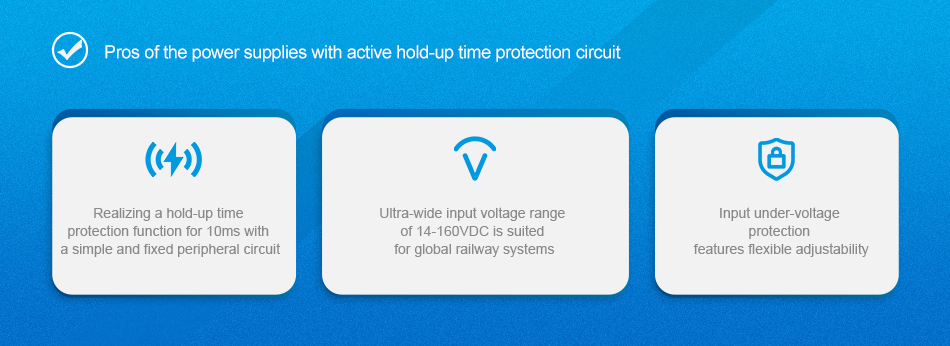
7. Summary
The railway power supply solution is not the only one, so how do choose and design a suitable power supply solution? Engineers can choose the traditional solution if they have fewer requirements for system size and certification. Or choosing the conventional topology solution if they have fewer requirements for the index of efficiency or hold-up time protection function. Or they can choose the more reassuring active hold-up time protection circuit solution if they want a high integration and suitable for various work conditions.
With the increase in industry demand and technical requirements, the product renovation rate becomes faster and faster. On the premise of satisfying the function, Mornsun keeps striving to pursue high efficiency and high reliability. Its ultra-wide input voltage railway power supply helps customers' systems to reduce cost and size, extend the usable life, reduce system design difficulty, reduce certification time, and finally, archives materials normalization and management cost reduction.






